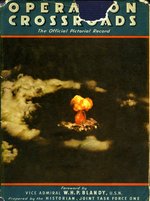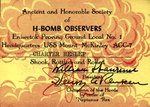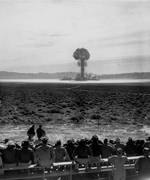On July 1, 1946 the fourth nuclear detonation in world history took place with the explosion of Able, a twenty-three kiloton bomb, 520 feet over the Bikini Atoll. On July 24, a complimentary bomb, Baker, was exploded ninety feet underwater at Bikini. This was Operation Crossroads.1 The program was officially designed to test the effects of the bomb on armored ships, but in practice it was a show of force meant to remind the American public, and Russian politicians, of the U.S.'s military strength.
The Marshall Islands tests were the first use of atomic weapons to receive significant criticism and resistance from scientists, government employees, and private activists before detonation. Radiation experts feared that the fallout from the tests would irradiate both the land mass of the atoll and an enormous quantity of sea water, making the entire area uninhabitable for indigenous life. Human and animal rights activists were also outraged by the tests, which required the displacement of the atoll's human population and incorporated test animals positioned within the blast zone.2
Moreover, the event had major political implications. Politicians advocating a nonproliferation treaty with the Soviet Union feared that talks would be stalled or ended by the test. Secretary of State Henry L. Stimson confronted President Truman directly, arguing that another bomb test would simply cement Russia's desire for nuclear armaments. Truman conceded and rescheduled the test from June to July to give diplomats time to reach an agreement. Alas, negotiations were still in progress by the July test date and disarmament talks were eventually discontinued.
The test itself was, in terms of public opinion, a failure. The actual strength of the explosions, though powerful, did relatively little damage to the target ships. Subsequent reports from nonplussed news sources led to a weakening of the American public's faith in the bomb. And to top it off, the U.S. only had nine functional nuclear weapons at the time of the Crossroads Test, ultimately destroying more than twenty percent of its arsenal at the atoll.
In January 1950 the U.S. military established the Nevada Test Site.3 Approximately seventy miles north of Las Vegas, it was designed to be a safe location where nuclear testing could be conducted without causing incidental loss of lives or property.
In 1952, the U.S. tested Ivy Mike, the first successful hydrogen bomb, at the Enewetok Atoll. The bomb was designed to test proof of concept rather than destructive power and was relatively small as a result. It proved to be a success, and the military began a program to improve on fusion designs. Two years later, the United States conducted the Castle Bravo test in the Pacific Proving Grounds.4 The Bravo test featured an untested dry-fuel composition with a larger yield than Ivy Mike. Because of its experimental nature, military scientists severely underestimated its explosive yield of fifteen megatons. The unexpected size of the explosion and a surprise change in weather patterns caused a number of Marshall Island natives and a Japanese shipping vessel to be exposed to nuclear fallout, in turn causing radiation sickness, burns, elevated incidents of cancer and birth defects, and the death of one Japanese fisherman. Two years later, the Pacific Proving Grounds was officially acknowledged to be the most highly irradiated location on the planet.
Not to be outdone, the Soviet Union conducted a number of its own tests, culminating in the largest nuclear detonation in history. The Tsar Bomba was exploded by the Soviet Union in 1961 with a yield estimated at an astounding fifty megatons.
Notes
- 1070. Baker Day, Operation Crossroads, 1946. Bikini Atoll, 1946. Return to text ↑
- 1074. Bradley David. "No Place to Hide. What the Bomb Did at Bikini." The Atlantic, October-December 1948. Concord, N.H.: The Atlantic Monthly. 1948. Return to text ↑
- 1100. Nevada Test Organization Office of Information. Background Information on Nevada Nuclear Tests, Revised to July 15, 1957. Las Vegas: OTI, 1957. U624.4.N3 B3343 1957. Return to text ↑
- 1088. Hines, Neal O. Proving Ground. An Account of the Radiobiological Studies in the Pacific, 1946-1961. Seattle: U. of Washington Press, 1962. RA569 .H5 1963. Return to text ↑




